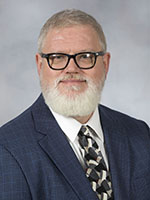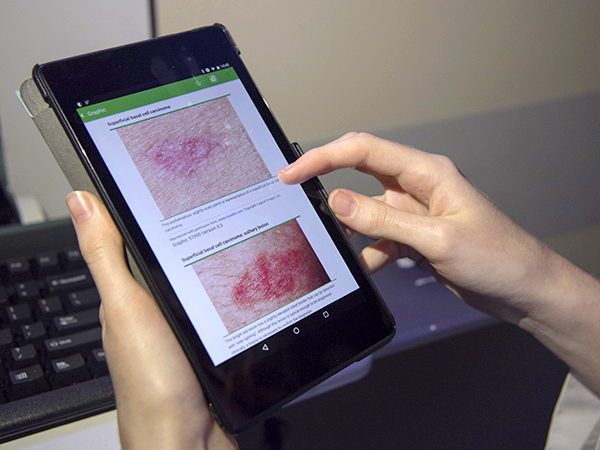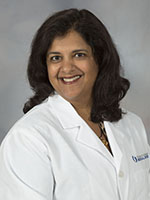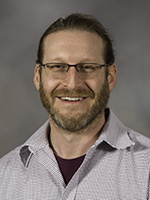Does an 'app' a day keep the medical textbook away? Not yet

Published in News Stories on February 20, 2017
Before the dawn of smartphones - around the Year 5 B.iP. (before iPhone), or the mid-1990s - Dr. Sajani Tipnis “barely had a cell phone,” she said.
“When I finally got one, it was because everyone was using them as pagers,” said Tipnis, associate professor of pediatrics, and assistant dean of curriculum.
Two decades ago, cell phones changed the way physicians and students were beeped; today, the cutting-edge descendants of these inexorable devices are shaping the way physicians practice medicine and, perhaps even more so, how students are learning it.
Medical education began to change once cell phones evolved into smartphones, and with the mass arrival of mobile apps which turned these gadgets into, among other things, medical libraries about the size of a spleen.

James
Physical, libraries-in-the-flesh are not disappearing, however, and, in fact, have become digital-age facilitators, said Dr. Dean James, associate professor of academic information services in the Medical Center's Rowland Medical Library.
“If we find out a resource has a mobile app, we'll let students know how to get it,” James said. “Students are still going to be purchasing textbooks - many professors assign certain ones.
“But whenever possible, the library wants to work with students and help them save money.”
The library also offers plentiful databases that pop up on your computer or smartphone, whether you're in the library or in a distant clinic or at home watching “General Hospital.”
This material includes copyrighted textbooks, James said. E-Books, e-Journals, databases and more are easily available, and visible, on the library's online home page, www.umc.edu/library/. This link describes the apps and explains how to download them: umc.libguides.com/mobileapps.
Of course, you can hunt for them on your own, but the choices can overwhelm.
“I've looked for an anatomy app on my phone, and there are maybe 15 of them,” said Dr. Ryan Darling, assistant professor of neurobiology and anatomical sciences. “I've gotten to the point where I can't keep up.”
Students, generally speaking, are less intimidated by this rich pageant, he said. This is true everywhere.
Released late in 2016, a survey of more than 700 medical students (https://www.hindawi.com/journals/ijta/2016/3929741/) shows that 90 percent believe the use of apps boosts their clinical knowledge.
Most (95 percent) said it saves time, and improves care (87 percent) and diagnostic accuracy (78 percent).
A particularly popular clinical app (out of 11 common ones broached in the survey) is UpToDate, a trove of summarized research studies, reports on medical news, and more.

Pearson uses UpToDate's mobile app to find information on basal cell carcinoma, the most frequently occurring form of skin cancer.
Hadley Pearson, a third-year medical student, depends on apps to “look up information on the fly;” those include UpToDate and two apps that provide access to Epic, the electronic health record system: Haiku and Citrix.
Even YouTube, which has an app, of course, is in on the act with, for instance, Anatomy Zone, a wellspring of gross anatomy lessons hosted by “a very nice British man,” Pearson said.
Another M3, Lauren Deaver, stays up to par with UpToDate and another of the survey's top apps: Epocrates, which delivers drug dosage calculations and information about side effects.
“These apps cut down on the number of other places I would have to go to look for this information,” Deaver said, “and they provide this material quickly as I'm rounding the wards.”
Johnny Lippincott, also an M3, noted that, while medical students have their favorite apps, he knows that “residents and physicians use them as well.”
One physician is Tipnis, a consumer of the neonatologists' friend, NeoFax, and BiliTool, a source for risk assessments and treatment guidelines regarding newborns.

Tipnis
“Depending on your specialty, there are a whole host of apps you can use,” Tipnis said.
“I do think it makes medical education different than when I went to school and didn't have this instant access to information. It makes our profession more efficient.
“And, while you may not have to remember as much as you used to because of these apps, you still need the base knowledge in order to know what to look up.”
But, speaking as an educator, Tipnis said, “I would prefer that the students go to the library and use PubMed for primary resources, to search for case studies.” UpToDate, for instance, only summarizes a lot of research studies, she said.
Anybody who's an authenticated UMMC user can tap into Rowland's resources, James said. You just need your UMMC username and password to access them off-campus.
“There are tricks to get more out of the databases,” James said. “It's not as simple as Google, which is why it pulls up a lot of garbage along with what's useful.
“We can't blame students for using Google; it's fast. But for more useful and accurate results, you need to learn to use these other resources.”
The majority of apps James is familiar with are tailored for medical and graduate students, and, in some cases, for nursing students/professionals: the Nursing Reference Center, for instance is “for nurses on the run.”
Micromedex, a font of drug dosage recommendations, can be a tonic for pharmacy students.
Some apps and e-textbooks are more accurate than others, however.

Darling
“As with anything on the Internet, you have to see who's making it and where your content experts are coming from,” Darling said. “You have to see if there is any empirical evidence that these products do what they say they do.”
Certain apps, for instance, get the anatomy wrong, he said. “Unless we are reading directly from the medical literature, some of this information is simplified. And when you simplify, you somewhat distort the truth to make it easier to understand.”
When it comes to choosing the best of these apps, Darling said, the “ideal landscape,” is inhabited by faculty working with students, “who are often more computer-literate than the faculty.
“We need to get a nice conversation going. Still, there are new apps coming out every week. Can we keep up with that? I don't know.”
What he does know is that “students are looking more and more to online content for learning. Why fight that?”


